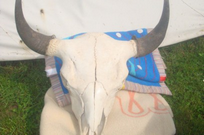Tatanka: About Bison
What does Tatanka mean?
Tatanka is a Lakota word that literally means “bull buffalo,” but Tatanka meant more than that. Ceremonies and daily life revolved around sacred reverence for Tatanka
Where did buffalo originate?
During the Ice Ages, much of the Earth’s seawater froze into glaciers, lowering sea level, and leaving dry land where there was once water. Shallow channels that separated land masses became grassy swales. One such “land bridge,” called Beringia, joined Siberia and Alaska. Archeologists theorize that the first people who came to this continent followed herds of horses, wooly mammoths, and ancient bison across this land bridge. When the ice ages ended, water filled in the low areas, again separating land masses. Of the animals that crossed the land bridge, wooly mammoths and horses eventually became extinct. Only the descendants of ancient bison — the buffalo we know today — survived to traverse the plains of North America in modern times.
How is a bison different from a buffalo?
The American bison is not a true buffalo in the scientific sense of the word, but most people use the word “buffalo” for this animal. Popular usage perpetuates the term “buffalo” even though “bison” is its scientific name. Bison and American buffalo are not two separate species. Here at Tatanka: Story of the Bison, we use both terms, interchangeably. The only true buffalo in the world are the cape buffalo and the water buffalo.
So, how did bison get the name buffalo?
French voyageurs referred to them as les boefs, meaning oxen. It also could have come from their term bufle or buffe which referred to good buffe, or hide.
What are some of the things Northern Plains tribes made out of the buffalo?
Bison were the basis of life for Plains Indians, providing spiritual inspiration, food, clothing, shelter, household items, tools, weapons, and ceremonial items. Plains Indians had over 100 uses for the various parts.
How many buffalo hides did it take to make a tipi?
Depending on the size of individual animals, it may have taken up to 18 bison hides to make a tipi for a large family.
How did Lakota people make a tipi?
To make a tipi, buffalo hides were soaked in the brains of the animal as a lubricant to make the fibers of the hide pliable after they dried. This is known as “brain-tanning.” Since there was no thread, native people sewed with “sinew,” or long fibers from muscles located close to the spine, which were shredded into long, thin strips.
How did a buffalo jump work?
A spectacular hunting method was to herd bison toward a precipice, or buffalo jump. Hunters working together could spook bison, getting them to stampede over a hidden drop off. Running bison, with no hint about the change in the lay of the land, raced toward certain death. People waiting at the bottom of the jump butchered the animals after they fell.
What was a good buffalo horse worth?
The Lakota hunter with the fastest, bravest, and most experienced horse could bring home more meat. This meant more prestige in the community; it also meant that horses became an important medium of exchange. A proven buffalo horse was invaluable to its owner and seldom traded. If you owned an average horse, you could trade it for any of the following items considered of equal value:
A good bow, 20 arrows, and a quiver
A flintlock rifle
Two elk-tooth dresses
A hide shield
Three sets of eagle tail feathers
How many buffalo were there?
It is difficult to get an accurate handle on the number of bison that existed before 1800. At one time, experts estimated it to be 60 million. Recent assessments of carrying capacity of the Great Plains estimate that the number was more likely 30 million. At any rate, the population was decimated by hunting — with fewer than 1,000 animals surviving.
How many years did it take for the near-extermination of the bison?
The slaughter and near-extermination of bison did not take place in a few violent years. Large-scale killing began as early as the 1820s with the advent of the hide and robe market, but most of the slaughter took place between the1830s and 1860s. The supply of animals seemed inexhaustible.
Why were the buffalo slaughtered?
For profit. Hides and tongues meant money. Additionally, when Euro-Americans realized that the native culture would change drastically if buffalo were eliminated, it seemed like a concerted effort to eradicate the animal to change the people. In the process of destroying the buffalo population, hunters cleared the way for Westward expansion and the old way of life of the Plains Indians disappeared.
Were the buffalo carcasses just left on the prairie?
Buffalo hunters, having taken the parts of the bison that were saleable, left the remains behind to rot. Eventually tons of useless bleached bones littered the prairie. In a commercial world, nothing is worthless for very long. Bones, hooves, and horns, shipped to eastern refineries, became bone ash fertilizer or an ingredient in refining sugar. Homesteaders augmented their living by collecting bones that sold for between $4 and $12 a ton. When Plains Indians could no longer deliver buffalo hides, some of them turned to the bone market, as well. It took one hundred buffalo skeletons to make a ton of bones.
How did those 100 buffalo survive?
Some men understood what lay ahead and captured or purchased bison for their ranches. The people who were instrumental in saving this species from extinction included Samuel Walking Coyote, Charles Allard, Michel Pablo, Charles Goodnight, Buffalo Jones, Pawnee Bill, Buffalo Bill, James “Scotty” Philip, and Fred DuPree.
How many buffalo are there today?
Today bison numbers are up to over 400,000 animals in North America.
Is it illegal to kill a buffalo?
It is not. Thousands of ranches raise bison for their meat.
Is buffalo meat good to eat?
The taste of bison is difficult to distinguish from beef. It is darker red and does not have the marbling of beef. Bison meat is a healthy alternative to other meats, with fewer calories and less fat than a skinless chicken breast.

